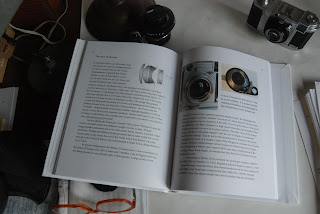Hubert Nerwin designed Zeiss Ikon's Tenax II camera of 1937 as a fast-action rangefinder camera with fully interchangeable lenses. That meant its lens offerings had to include at least one wide angle. This proved to be a bit of a challenge. There were few options in wide-angle designs in the 1930s. Initially the Contax had made do with a slow 2.8cm f8 Tessar that did not even couple to the rangefinder. The later fast and sharp 3.5cm f2.8 Biogon was the best wide-angle that any lens manufacturer could offer at that time, but its depth precluded its use on the Tenax. So Nerwin chose an Orthometar design.
The Orthometar was designed as an aerial lens by Dr. Robert Richter. As its name implies, it was particularly free of distortion—an important consideration in a lens used for aerial mapping. A modified double Gauss design, it appears similar to the 28mm f3.5 W-Nikkor for the Nikon RF cameras except for a much smaller back element.
Zeiss also took the design and used it in a 3.5cm f4.5 lens for the Contax cameras—slower than the Biogon, but priced at a lower price point than the Biogon.
Adapted for use on a 24X24 format camera, such as the Tenax II, the 27mm focal length yields the same angle of view as a 34mm lens on a 24X36mm camera.
Although it takes the same 34.5mm screw-in filters as the other lenses for the Tenax, the Orthometar optics are small, a mere 6mm across the front. Grinding the inner elements must have been a difficult and challenging task. The five aperture blades are also tiny. The spaces between aperture markings are even and the aperture closes down to f32. The barrel does not rotate when focused. This is a modern lens lacking only clickstops to make it comparable to any RF lens made today. It focuses down to less than three feet with a 30 degree swing of its under lens focusing lever.
Carl Zeiss made only three lots of this lens: two prototypes in 1937 (nos 2025791 and 2025792), then a production run of 100 finished on October 1st, 1937 (nos.2203301-2203400). A final run of 200 probably came close to a year later (nos 2360001-2360200). The lens was expensive ($132 dollars, or equivalent to over $2200 at 2017 rates) and the market for wide-angles limited. The outbreak of World War II less than a year-and-a-half after the camera’s introduction undoubtedly contributed to the low numbers and small sales.
With such a small production, it is a wonder that this lens is available at all, but I snagged the one illustrated here off ebay with a buy-right-now option complete with its finder and a Tenax camera and custom case. Unfortunately, the camera had been dropped, but with parts on hand I have been able to get everything back in working order.
The lens is easy to use and the results sharp. I like its compactness and easy to set controls.
More details on the Orthometar for the Tenax can be found in my book on the Tenax II, available from Blurb Books:
 |
| Orthometar mounted on its original Tenax with finder 482/6 |
 |
| Orthometar images |







